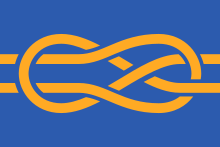Vexillology

Vexillology (/ˌvɛksɪˈlɒlədʒi/) is the study of the history, symbolism and usage of flags or, by extension, any interest in flags in general.[1] The word is a synthesis of the Latin word vexillum ("flag") and the Greek suffix -logia ("study").[2]
A person who studies flags is a vexillologist, one who designs flags is a vexillographer, and the art of flag-designing is called vexillography. One who is a hobbyist or general admirer of flags is a vexillophile.
History
This section needs expansion. You can help by adding to it. (March 2018) |
The study of flags, or vexillology, was formalized by the U.S. scholar and student of flags Whitney Smith in 1961 with the publication of The Flag Bulletin.[3] During his lifetime, Smith organized various flag organizations and meetings including the first International Congress of Vexillology (ICV), the North American Vexillological Association, and the International Federation of Vexillological Associations (FIAV).[4] Smith, who is acknowledged as conceiving the term "vexillology" in 1957, wrote "[w]hile the use of flags goes back to the earliest days of human civilization, the study of that usage in a serious fashion is so recent that the term for it ... did not appear in print until 1959."[5] Before this time, study of flags was generally considered a part of heraldry.
Involvement in vexillology includes academic work in fields such as sociology, history or design, professional or otherwise, contributions from the flag industry, and interest from those simply passionate about flags. ICV and local vexillological meetings often cover a wide range of interest in flags. Since 1969, an International Congress of Vexillology has been organized every two years under the auspices of FIAV; papers presented at an ICV are published afterwards as the Congress's Proceedings.[3]
Design philosophy
Flags flap. Flags drape. Flags must be seen from a distance and from their opposite side. Under these circumstances, only simple designs make effective flags. Furthermore, complicated flags cost more to make, which often can limit how widely they are used. Most poor designs have the elements of a great flag in them—simplify them by focusing on a single symbol, a few colors, large shapes, and no lettering. Avoid the temptation to include a symbol for everybody.[6]
— North American Vexillological Association, First rule of flag design: Keep it simple
See also
References
- ^ Smith, Whitney. Flags Through the Ages and Across the World New York: McGraw-Hill, 1975. Print.
- ^ "About Vexillology - The Flag Institute". The Flag Institute. Retrieved 2018-06-01.
- ^ a b "CONSIDER VEXILLOLOGY. – SemiotiX". semioticon.com. Retrieved 2018-04-01.
- ^ Vulliamy, Elsa (December 15, 2015). "Which flag is it? Take our quiz to find out". Retrieved March 13, 2016.
- ^ "Vexillology". www.crwflags.com. Retrieved 2017-11-03.
- ^ https://www.ausflag.com.au/assets/images/good-Flag-Bad-Flag.pdf
Further reading
- Leepson, Marc. Flag: An American Biography. New York: Thomas Dunne Books, 2005.
- Smith, Whitney. Flags Through the Ages and Across the World. New York: McGraw-Hill, 1975.
External links
 Media related to Vexillology at Wikimedia Commons
Media related to Vexillology at Wikimedia Commons



